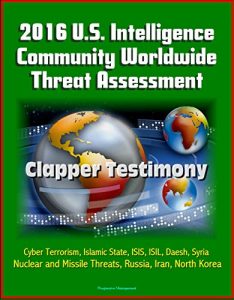Director of National Intelligence James R. Clapper Jr. presented the 2016 annual U.S. intelligence community worldwide threat assessment in Congressional testimony on February 9, 2016. In the published report, Clapper provides a thorough review of the status of possible threats from a wide variety of nations and terror groups. In addition to the 2016 assessment, this compilation includes the 2015, 2014, 2013, and 2012 assessments for comparison and historical reference, plus important additional material, including the 2016 Defense Intelligence Agency worldwide threat assessment, the Obama White House National Security Strategy issued in early February 2015, remarks by National Security Advisor Susan Rice on the NSS, and dozens of statements on national security and the intelligence community from expert witnesses and officials.
Obviously, the Islamic State (ISIS, or ISIL) is a major focus of these assessments, along with cyber threats from Russia, China, Iran, and North Korea. Other topics covered: GLOBAL THREATS * Cyber and Technology Terrorism * Weapons of Mass Destruction and Proliferation * Space and Counterspace * Counterintelligence * Transnational Organized Crime * Economics and Natural Resources * Human Security * REGIONAL THREATS * East Asia * China * Southeast Asia * North Korea * Russia and Eurasia * Russia * Ukraine, Belarus, and Moldova * The Caucasus and Central Asia * Europe * Key Partners * The Balkans * Turkey * Middle East and North Africa * Iraq * Syria * Libya * Yemen * Iran * Lebanon * Egypt * Tunisia * South Asia * Afghanistan * Bangladesh * Pakistan and India * Sub-Saharan Africa * Central Africa * Somalia * South Sudan * Sudan * Nigeria * Latin America and Caribbean * Central America * Cuba * Venezuela * Brazil.
The United States and its allies are facing a challenging threat environment in 2016. Sunni violent extremism has been on an upward trajectory since the late 1970s and has more groups, members, and safe havens than at any other point in history. At the same time, Shia violent extremists will probably deepen sectarian tensions in response to real and perceived threats from Sunni violent extremists and to advance Iranian influence.
The Islamic State of Iraq and the Levant (ISIL) has become the preeminent terrorist threat because of its self-described caliphate in Syria and Iraq, its branches and emerging branches in other countries, and its increasing ability to direct and inspire attacks against a wide range of targets around the world. ISIL's narrative supports jihadist recruiting, attracts others to travel to Iraq and Syria, draws individuals and groups to declare allegiance to ISIL, and justifies attacks across the globe. The ISIL-directed November 2015 attacks in Paris and ISIL-Sinai's claim of responsibility for the late October downing of a Russian airliner in the Sinai underscore these dynamics.
Al-Qa'ida's affiliates have proven resilient and are positioned to make gains in 2016, despite counterterrorism pressure that has largely degraded the network's leadership in Afghanistan and Pakistan. They will continue to pose a threat to local, regional, and even possibly global interests as demonstrated by the January 2015 attack on French satirical newspaper Charlie Hebdo by individuals linked to al-Qa'ida in the Arabian Peninsula (AQAP). Other Sunni terrorist groups retain the ability to attract recruits and resources.
Obviously, the Islamic State (ISIS, or ISIL) is a major focus of these assessments, along with cyber threats from Russia, China, Iran, and North Korea. Other topics covered: GLOBAL THREATS * Cyber and Technology Terrorism * Weapons of Mass Destruction and Proliferation * Space and Counterspace * Counterintelligence * Transnational Organized Crime * Economics and Natural Resources * Human Security * REGIONAL THREATS * East Asia * China * Southeast Asia * North Korea * Russia and Eurasia * Russia * Ukraine, Belarus, and Moldova * The Caucasus and Central Asia * Europe * Key Partners * The Balkans * Turkey * Middle East and North Africa * Iraq * Syria * Libya * Yemen * Iran * Lebanon * Egypt * Tunisia * South Asia * Afghanistan * Bangladesh * Pakistan and India * Sub-Saharan Africa * Central Africa * Somalia * South Sudan * Sudan * Nigeria * Latin America and Caribbean * Central America * Cuba * Venezuela * Brazil.
The United States and its allies are facing a challenging threat environment in 2016. Sunni violent extremism has been on an upward trajectory since the late 1970s and has more groups, members, and safe havens than at any other point in history. At the same time, Shia violent extremists will probably deepen sectarian tensions in response to real and perceived threats from Sunni violent extremists and to advance Iranian influence.
The Islamic State of Iraq and the Levant (ISIL) has become the preeminent terrorist threat because of its self-described caliphate in Syria and Iraq, its branches and emerging branches in other countries, and its increasing ability to direct and inspire attacks against a wide range of targets around the world. ISIL's narrative supports jihadist recruiting, attracts others to travel to Iraq and Syria, draws individuals and groups to declare allegiance to ISIL, and justifies attacks across the globe. The ISIL-directed November 2015 attacks in Paris and ISIL-Sinai's claim of responsibility for the late October downing of a Russian airliner in the Sinai underscore these dynamics.
Al-Qa'ida's affiliates have proven resilient and are positioned to make gains in 2016, despite counterterrorism pressure that has largely degraded the network's leadership in Afghanistan and Pakistan. They will continue to pose a threat to local, regional, and even possibly global interests as demonstrated by the January 2015 attack on French satirical newspaper Charlie Hebdo by individuals linked to al-Qa'ida in the Arabian Peninsula (AQAP). Other Sunni terrorist groups retain the ability to attract recruits and resources.



